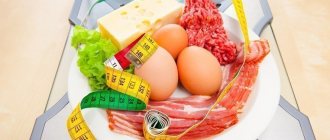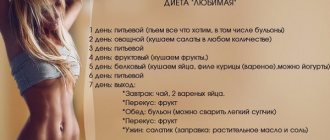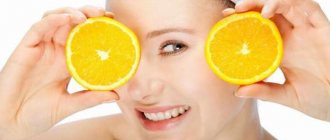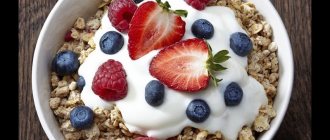The article talks about the salt-free diet, one of the most popular methods of losing weight, the principles of which are followed today by millions of people around the world. You will learn what a diet is like without one of the most attractive decorations for various dishes.
You will also get acquainted with thematic video materials, study contraindications, receive direct recommendations on creating the right menu for two weeks and acquire a list of seasonings that can replace salt in your daily diet.
What is the essence of the diet?
The technique involves limiting the intake of salt (sodium chloride) into the body. In radical options, sodium chloride is eliminated completely and supplied only in the amount contained in approved products. A more common option is to reduce the amount of additive in cooked dishes.
Sodium retains water in the body and slows down metabolism; accordingly, weight loss when refusing the supplement occurs not due to fat burning, but, first of all, due to the removal of excess fluid from the body and improved metabolism.
Indications and contraindications
Reducing the amount of sodium chloride in the diet is prescribed, including for medical reasons. You should pay attention to changes in the amount of salt in food:
- In the presence of edema.
- For kidney diseases.
- For high blood pressure (low-salt diet).
- If you have cellulite and excess weight.
- For stomach diseases.
But this method will not work:
- Children and teenagers under 18 years of age.
- Pregnant and lactating women.
- For diseases of the heart muscle.
- With high cholesterol.
- People engaged in heavy physical labor.
You should not practice the diet in the hot season, because... with increased sweating, the water-salt balance is disturbed and a lack of sodium chloride can negatively affect the overall health.
Benefits and harms
Normally, a person needs to consume 10-12 grams of salt daily, but in fact, every day we exceed this norm at least twice. Excess sodium, in turn, retains fluid in the body, slows down the breakdown of cholesterol and contributes to the formation of cellulite. Refusal of the supplement leads to balancing of the water-salt balance in the body without additional effort and normalization of organ function. This is an undeniable advantage of the method.

But sodium is necessary for the normal functioning of the nervous system, for the transmission of electrical impulses in the muscles and for the functioning of the heart. Accordingly, a deficiency of this element can affect each of these systems.
Diet menu for two weeks
If you are on a 14-day diet, you can use the above menu for a week. From the eighth day it will have to be repeated.
There is another option - eat the same foods every 3 days. In this case, the menu will be like this:
- for the first 3 days you are allowed to eat 0.5 kg of lean boiled meat per day;
- from days 4 to 6, replace the meat with boiled fish (it’s better if it’s cod);
- Days 7-9 – any porridge in combination with low-fat milk;
- 10-12 days – any vegetables (except potatoes) raw or baked (no more than 3 kg);
- Day 13-14 – no more than 2 kg of any fruit (except bananas and grapes).
Don't forget about your drinking regime. It involves drinking enough clean water, green tea and other unsweetened drinks.
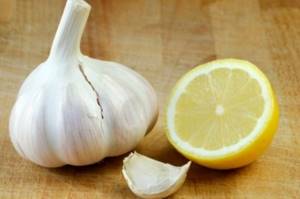
Possible side effects
As I already said, a disadvantage of the diet can be an acute shortage of necessary elements. If you completely limit the intake of the supplement into the body for a long time, this can lead to:
- Convulsive seizures.
- Disorientation.
- Muscle weakness and spasms.
- Fatigue.
- Loss of appetite and nausea.
- Increased risk of cardiovascular diseases.
In some cases, a lack of sodium can lead to cerebral edema, which is why you can completely abandon the supplement for a period of more than two weeks only as prescribed by a doctor and under his supervision.
Kinds
The recommendation to reduce the amount of salt in the diet is typical for many diets, but there are several of the most popular varieties, which I will now discuss.
Protein
The essence of such nutrition is the predominance of protein foods in the diet. The menu is based on lean meats and fish (boiled and steamed), low-fat dairy products, and eggs. A protein-salt-free diet does not imply a complete rejection of fats and carbohydrates, but requires minimizing them. This diet ends with a few days of eating vegetables and fruits.
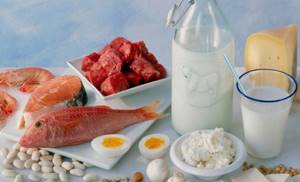
Chinese
This method of rapid weight loss involves giving up salt while reducing the overall calorie content of dishes and portion sizes. This is a very strict diet schedule, in which sugar, spices and herbs are prohibited, and all dishes are steamed, boiled or baked. Naturally, there is no talk of any buns or sausages. The menu mainly consists of lean meat, fish, vegetables, eggs and tea. The diet lasts 14 days and allows you to lose about 10 kg of excess weight, but due to the large number of restrictions, very few people reach the finish line.
Japanese
This type of food has nothing to do with Japan. By and large, it only means giving up sodium chloride (and products containing it), sugar, alcohol and baked goods. There are no other product restrictions. If possible, it is necessary to give preference to products that have not undergone heat treatment. It is better to steam or boil. You need to drink 1.5 liters of clean water per day. This diet causes less stress to the body and allows you to lose 5-7 kilos in 2 weeks.
Authorized Products
In terms of food restrictions, this type of diet is not too strict.
- Dairy and fermented milk products (milk, yogurt, kefir, low-fat cottage cheese, etc., with the exception of salted butter).
- Berries, fruits and vegetables without restrictions (fresh or frozen).
- Any fruit juices, as well as vegetable juices without salt.
- Bread and bakery products (limit up to 200 g per day). You can eat bread without adding salt, waffles, crackers, biscuits.
- Porridge without salt (oatmeal, buckwheat, corn, barley and others).
- Legumes (beans).
- Soups (vegetable or fish broth).
- Eggs (1 chicken egg per day).
- Meat and fish (lean beef, lean fish, skinless poultry).
- Dried fruits (dried apricots, raisins, prunes).
- Spices (dry only). In addition, you can use lemon juice, garlic, vinegar.
- Nuts.
- Weak green tea.
- Coffee.
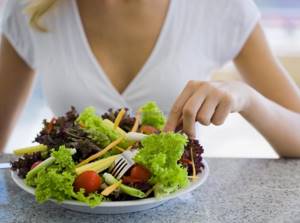
Rules
With the right and rational approach, the diet will give visible results and will not cause harm.
Permitted, Prohibited and Restricted Products
When eating a salt-free diet, it is strictly forbidden to consume:
- Salt (naturally) and salt-containing additives (spices, mayonnaise, sauces, etc.).
- Canned foods, pickles, sausages, sausages and other products that contain sodium chloride.
- Flour and baked goods.
- Spicy, fatty and smoked foods.
- Alcohol, carbonated drinks and packaged juices.
- Sweet fruits and berries.
- Pasta.
Can be eaten:
- Lean meat and fish.
- Cereals.
- Dairy products.
- Eggs.
- Vegetables and unsweetened fruits.
- Nuts, dried fruits.
- Whole grain and rye bread.
It is recommended to add just a little salt to prepared dishes and only after cooking.
Preparation
2 weeks before starting the diet, gradually remove prohibited foods from your diet, reduce the amount of salt and spices in your dishes - this way your taste preferences will gradually adjust and the food will not seem bland to you.
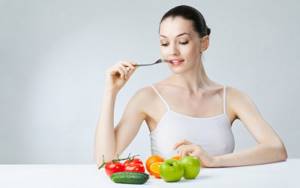
Duration
Nutritionists recommend sticking to this diet for 7-14 days. But if you begin to feel unwell in the middle of the course, complete it immediately and see a doctor. You should consult your doctor and, if you want to extend the salt-free diet for a longer period, he will tell you exactly how long you can stay on such a diet.
Quitting the diet
To complete the salt-free regime, it is necessary to gradually add new foods to the diet. Because In many ways, extra pounds are lost due to fluid loss, and after finishing the diet, try to control your sodium chloride intake and keep it at the daily norm.
Can it be combined with other diets?
As I already said, limited salt intake is recommended in various diets, so if you slightly reduce your intake of this supplement, this will only be beneficial. But we are only talking about reducing the intake of the substance in the body to the daily norm, but not about completely abandoning it.
Features of a salt-free diet for weight loss
While following a diet, you are allowed to add a little salt to your food, and this can only be done when the dish is already ready. Meals should be fractional - we eat little and often.
To prevent the dish from seeming tasteless and too bland, onions, garlic or herbs are added to it. Judging by the reviews about the salt-free diet, over time you get used to such a diet, and new taste sensations open up - the food becomes much tastier and more aromatic.
Prohibited foods during the diet
- everything spicy and fatty, fried and smoked;
- sausages, sausages and other products with excessive salt content;
- marinades and pickles;
- sweets and confectionery products.
Basic foods for a salt-free diet
- vegetable broths;
- a variety of vegetables, both raw and boiled;
- low-fat meat and fish broths;
- bread made from wheat and rye flour;
- skim milk and fermented milk products: cottage cheese, kefir, yoghurts;
- fresh fruits and berries, dried fruits;
- fruit jelly, tea.
Recipes for diet
In the salt-free mode, you can use a small amount of vegetable oil, which is best added to ready-made dishes. For flavor, you can add onions, garlic, and spices. The choice of products for cooking is quite wide, so the main problem will not be what to cook, but how to eat it without salt. Here are some recipe ideas for every day.
Recipe 1. Beef Stroganoff
Boil 1 kg of beef, remove membranes and cut into strips. Finely chop 2 boiled carrots, parsley and a little onion. Pour a sauce of low-fat sour cream, unsalted tomato paste and beef broth over all ingredients and simmer for 10-15 minutes over low heat.
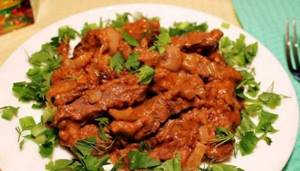
Recipe 2. Cauliflower soup with zucchini
We take cabbage and zucchini in equal proportions. Divide the cauliflower into florets, peel the zucchini and cut into cubes. Add zucchini and cabbage to boiling water and cook until tender. Grind the prepared vegetables into puree and boil. Prepare a mixture of hot milk and egg yolk and mix with puree to the desired consistency. The finished soup can be decorated with herbs.
Recipe 3. Fruit salad with yogurt
Peel kiwis, tangerines and bananas. Peel and core the apples. Cut all fruits into small cubes. Place the chopped fruit in a bowl or bowl and pour yogurt over it. On top of the salad you can decorate with orange zest, nuts and dried fruits.
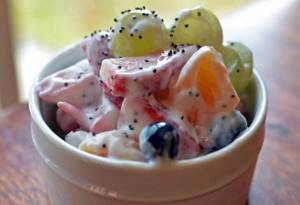
List of prohibited products
While following a diet, it is necessary to limit the consumption of a number of foods:
- meat broth;
- fatty and fried foods;
- smoked meats, pickles, as well as dried fish and meat;
- semi-finished products (especially meat);
- fast food;
- instant noodles;
- mayonnaise, ketchup and other sauces from the store;
- bakery products made with salt;
- canned vegetables and fruits;
- sweets, including jams, cakes, candies;
- sweet berries and fruits;
- alcohol.
In order not to lose your temper and eat something forbidden, at first you can add a little salt to your food.
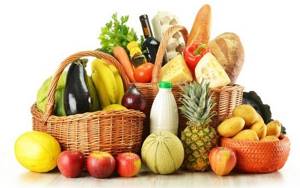
Sample menu
I offer you options for different dishes, and you can combine them yourself according to the days of the week, as is more convenient for you, and create your own nutrition table.
Breakfast:
- Tea with milk.
- Cottage cheese.
- Salt-free bread.
- Boiled egg.
- Porridge with water or milk.
Lunch:
- Baked apple.
- Rose hip decoction.
- Diet crackers.
- Charlotte.
Dinner
- Vegetable puree soup.
- Chicken beef stroganoff.
- Boiled beef.
- Fish soup.
- Vegetable salad.
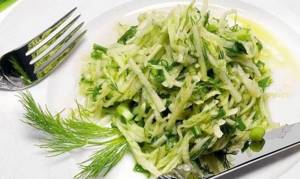
Afternoon snack
- Fruits, nuts.
- Yogurt.
Dinner
- Omelette.
- Steamed fish.
- Boiled chicken.
- Vegetable stew.
Menu for 14 days
It is not recommended to follow the method for more than two weeks. And we tried to create a sample menu for you for this period.
First week.
Monday:
- breakfast: rolled oats with dried fruits, a glass of low-fat kefir, ginger drink;
- lunch: pita bread with turkey breast, stewed vegetables, a glass of carrot juice;
- lunch: cottage cheese pie with apples, tea;
- dinner: goulash, buckwheat.
Tuesday:
- breakfast assorted fruit, herbal tea, whole grain bread;
- lunch: fish soup, cabbage and carrot salad;
- lunch: cheesecakes;
- dinner: rolls with avocado or cucumber, beet juice.
Wednesday:
- breakfast apricot pie, pomegranate juice;
- lunch: barley with meat, cooked in the oven;
- afternoon snack: assorted fruits and berries;
- dinner: chicken with garlic or herbs de Provence, hard-boiled egg.
Thursday:
- breakfast cottage cheese casserole, green tea;
- lunch: baked broccoli with chicken, chicken egg, stewed eggplant caviar;
- lunch: cheesecakes, apricot juice;
- dinner: steamed meat, beetroot and carrot salad with garlic, cucumber juice.
Friday:
- breakfast: natural low-fat yogurt, fruit to taste;
- lunch: soup with potatoes and vegetables to taste, baked fish fillet, a glass of carrot juice;
- lunch: assorted fruits and berries;
- dinner: pie with cottage cheese and dried fruits.
Saturday:
- breakfast: rolled oats with dried fruits, low-fat kefir;
- lunch: casserole with meat and potatoes, ginger tea;
- lunch: assorted fruits and berries;
- dinner: meat on the sleeve with vegetable stew.
Sunday:
- breakfast: vanilla cheesecake, ginger drink;
- lunch: light soup with dumplings, egg, apple-beet salad
- lunch: plums, natural yogurt;
- dinner: pearl barley porridge.
Week two
Monday:
- breakfast: buckwheat, a glass of low-fat fermented baked milk, ginger tea;
- lunch: fish and vegetable soup, turkey breast, freshly squeezed beetroot and carrot juice;
- lunch: plum pie, herbal tea;
- dinner: meat with vegetables in a sleeve with herbs.
Tuesday:
- breakfast: berry and fruit cheesecake, ginger drink, crackers;
- lunch: fish soup, apple and carrot salad with garlic;
- lunch: tartlet with berries and curd cheese, ginger tea;
- dinner: turkey breast with steamed vegetables, carrot juice.
Wednesday:
- breakfast apple pie, herbal tea
- lunch: buckwheat with meat in the sleeve;
- lunch: favorite fruit;
- dinner: curd mass with dried fruits.
Thursday:
- breakfast vanilla cheesecake, ginger drink;
- lunch: steamed veal, eggplant caviar;
- lunch: cheesecakes, apple juice;
- dinner: steamed turkey, sliced vegetables, carrot juice.
Friday:
- breakfast: low-fat kefir, apricots or plums;
- lunch: fish soup, chicken fillet with Provençal herbs, a glass of beet juice;
- lunch: plums, apricots or citrus fruits;
- dinner: curd mass with dried fruits.
Saturday:
- breakfast: rolled oats with prunes, low-fat fermented baked milk;
- lunch: fish soup, stewed vegetables;
- lunch: assorted fruits and berries;
- dinner: vegetable casserole with white meat.
Sunday:
- breakfast: apricot pie, ginger drink;
- lunch: fish casserole, egg, carrot salad;
- lunch: assorted fruits and berries, low-fat kefir;
- dinner: oatmeal with dried fruits.
Reviews and results of losing weight
Among those losing weight in this way, the most common is the Japanese diet, which is less restrictive to the diet, but at the same time is one of the most effective. In general, those losing weight are satisfied, but many videos say that it is very important to control the intake of sodium into the body, because by the end of strict salt abstinence, some note pain in the heart and weakness.
As usual, I have collected photos for you that clearly show the results of two weeks of quitting the supplement.
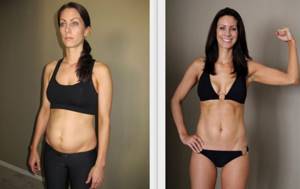
How can you replace salt on a salt-free diet?
Most people don’t even consider that a healthier alternative can be found instead of salt.
Soy sauce
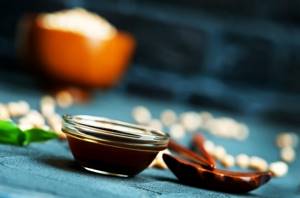
It already contains salt, so you need to add soy sauce to dishes in small quantities. Properly prepared, natural sauce is rich in amino acids, beneficial microelements and vitamins. Among anti-aging foods, it is considered even more effective than red wine. A quality product should not contain anything other than soybeans and wheat. There should be no preservatives. The daily dose of the product is 2 tbsp.
Sea salt
This salt is obtained by evaporating sea water. On store shelves, salt is found in the form of powders. The powdery form indicates that the product has been bleached and refined. It is better to refuse to purchase such a product, because... During mechanical processing, salt lost all its beneficial properties. The ideal sea salt is large, light gray crystals. The manufacturing technology is reduced to drying under the sun's rays. Using it on a salt-free diet in reasonable quantities has a healing effect on the body. The main thing is not to neglect the basic rule - salt the food after cooking, so that the salt is not subjected to heat treatment.
Seaweed (kelp)
Laminaria is used fresh or dried. Seaweed is a source of iodine, beneficial minerals and vitamins. They naturally have a salty taste. Dried kelp is crushed and sprinkled on dishes.
Spices and juices
By dressing the salad with lemon juice, no one will notice the lack of salt. It will turn out even tastier if you combine juice with spices.
Hot ginger root and horseradish will be an excellent alternative not only to salt, but also to hot spices. They are added to food dried, fresh or in the form of sauces. Horseradish contains ascorbic acid and minerals. It is called "natural antibiotic". Ginger root fights fatigue and fatigue.
An unusually tasty addition can be cilantro, dill, parsley, oregano, and basil. All of them will improve the functioning of the digestive system.
What nutritionists say
Many nutritionists say that on a salt-free diet, weight decreases solely due to water leaving the body. Once you return to your normal diet, the kilograms will return. In addition, the thoughtless complete exclusion of sodium chloride from the diet is fraught with serious health problems, so doctors recommend consulting with them in advance so as not to pay too high a price for lost kilograms.
Everything is good in moderation. This is perhaps the best description of how salt should be consumed. I agree with nutritionists: we eat too much of this supplement. Therefore, my personal opinion is that nutrition should be approached comprehensively and in the context of a long period of time. You can’t give up salt for 2 weeks, lose weight, and then start eating smoked meats and cakes again until the next time you go on a diet. It is much easier to constantly eat healthy, balanced, move and exercise more. What do you think? Have you tried quitting this supplement? Tell us about your experience and don't forget to subscribe to my blog updates!
Quitting the diet
The right way out of a salt-free diet is the key to maintaining the achieved results. During the diet, you can lose from 4 to 10 kg in 2 weeks, and it is better to come out of it within two weeks - gradually and intelligently.
- Immediately after finishing the diet, it is necessary to gradually introduce smoked and salty foods into the diet, each time slightly increasing the portion to the size that is familiar to you. But remember that excessive consumption of unhealthy foods will sooner or later affect your health, even if you follow various healthy diets at times.
- The same applies to confectionery products - you should not overeat on them, otherwise you risk gaining several extra pounds in a matter of days, which you so wanted to get rid of.
- Do not over-salt your food even several months after the diet - let your dishes always be moderately salty. This will allow the body to receive exactly as much salt as it needs.


